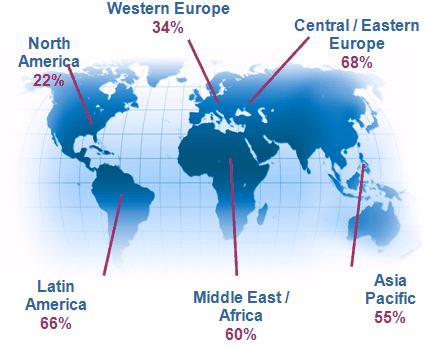Borrowing Software
COMP1260 > Application Software
IntroductionCan you imagine a computer without any software applications? It's just a big chunk of hardware that does nothing. Software makes computers functional. For quite a few of us, buying software is near impossible. We want to make our computers do everything, but that would cost us a fortune. That’s why people tend to take a shortcut by “borrowing” software instead of buying it. “Borrowing” software is no different than stealing or shoplifting.
|
...by studentsI used to be a pirate. I found pirating software to be very convenient because it is really easy to download and install, and costs nothing. With high speed internet access and unprotected software accessible over the internet, pirating software is just as easy as snapping the fingers. I used to "borrow" software a lot, but after becoming a Computer Science student and trying to create software on my own, I realized for the first time how much effort it requires. I no longer "borrow" software, because I will not be very happy if people steal my work in the future. You know how piracy cripples software developers, and you are faced with a difficult choice. Do you still want to "borrow" software?? Let your conscience decide. |
What is “Borrowing” software
“Borrowing” software refers to activities where we “borrow” software without permission. To legally use the software we need to get the license from the copyright holder. Software is fairly easy to get nowadays. They can be shared using peer-to-peer applications, CDs or can be downloaded from internet. When you purchase software in a store, you are not actually purchasing the software itself, you are purchasing the license to use the software. Using a copy of software without obtaining permission to use that copy ( normally granted through a license ) is often referred to as pirating software.
Many Ways Piracy is Done
There are many ways piracy can be done:
- Softlifting: Purchasing a single licensed copy of software installing it on more computers than is legally permitted in the license.
- Uploading and downloading: Making unauthorized copies of copyrighted software available over the internet.
- Software Counterfeiting: Duplicating unauthorized copies of software in a form designed to make it appear legitimate.
- OEM infringement/unbundling: Selling standalone software that was intended to be bundled with other software/hardware.
- Hard-disk loading: Selling computers with preloaded illegal software.
- Commercial use of non-commercial software: Using educational or other commercial-use-restricted software for commercial use
- Unrestricted client access infringement: Installing software in a server computer, so all the client computers are free to access the software. Note that sometimes this is allowed based on the terms of the license of agreement.
Impact of Piracy
You may think that piracy is victimless. Projects to build software are typically team-oriented, complicated and continuous. They need an extensive amount of work. Software developers put huge investments into their projects, and expect the revenue to cover all of the expenses. Then, the company can survive and do some further research and development to improve the existing program and even create new software. By pirating, you cause software developers to lose revenue. Last year, 2007, software developers lost $48 billion in revenue worldwide according to Business Software Alliance(BSA)]. This causes those companies to do less research and development which would have benefited the legitimate users. The loss of revenue would cause job, retail, and government tax losses, and at the end it would have significant impact on the economy. Piracy hurts everyone.
Myths about Software Copy Protection
There is one thing software developers can do to prevent their software from being pirated: by applying software copy protection. However, there are myths about software copy protection which discourage software developer to use software copy protection.
- Software piracy is a victimless crime. This is entirely wrong. Software developers lost $48 billion of revenues worldwide in 2007 – $9 billion to software developers in North America. This is software piracy study in May 2007
- Software copy protection makes software more expensive. The cost of software copy protection is negligible compared to the loss of revenues due to piracy.
- Software copy protection gets in the way of legitimate users. Modern software copy protection, like HASP, does not only get in the way of legitimate users, but also benefits them.
- Inexpensive software is not copied Myths saying: “Don’t use software copy protection, just sell the software at low price, people don’t pirate cheap software”. This myth is unreliable and incorrect. Research and development is not a cheap investment, software cannot be sold that cheap and maybe software that gets copied the most are the cheaper ones.
- Any Protection can be cracked. Therefore, software copy protection is useless Only the first part is true. All protection can be broken or cracked eventually, but there will always the better ones later on. However, software copy protection is not useless. It will at least protect the software for a little while and give obstacles to the hacker.
It is true that no protection is unbreakable. It is like security systems and thieves where security systems always get better and more secured over time and thieves always get smarter to break the security systems. Therefore, software copy protections have to evolve over time.
Further Readings
- http://www.uni.uiuc.edu/~dstone/piracy.html
- http://www.cit.cornell.edu/policy/copyright/software.html
- http://en.wikipedia.org/wiki/Digital_rights_management - DRM
- http://en.wikipedia.org/wiki/SecuROM - secuROM
References
- http://www.microsoft.com/piracy/
- http://en.wikipedia.org/wiki/Copyright_infringement_of_software
- http://www.bsa.org/country/BSA%20and%20Members.aspx
- http://www.aladdin.com/hasp/solutions/software-security.aspx
|
Previous Page: Installing and Uninstalling |
